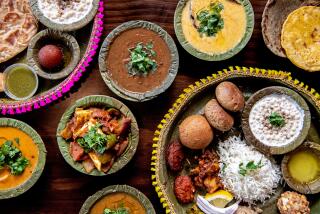India’s Festival of Lights
- Share via
India’s glittering festival of lights, Diwali, takes place Nov. 3. It’s a happy holiday that celebrates the triumph of good over evil and signals a fresh start for the business community.
The name Diwali comes from Sanskrit words meaning row of lights. In India, window ledges and roof tops gleam with rows of tiny pottery lamps that are fueled by oil or ghee, the clarified butter used in cooking.
People dress in their finest clothing. Homes are swept clean. Diwali cards are exchanged, and hours are spent preparing holiday sweets. Merchants open and bless new account books at this time and offer prayers for prosperity to Lakshmi, goddess of wealth.
The celebration starts days before Diwali with ritual dances and dramas that depict the victory of the Hindu god Rama over evil forces. Drawn from the Ramayana, an Indian epic, the dramas are performed by townspeople on neighborhood stages.
*
“It’s sparkling and magical; it’s a very rich and exciting time,” says Linda Alipuria of Chameli, a north Indian vegetarian restaurant in Rosemead. The restaurant hosted a Ramayana reading last weekend and has on display Diwali storybooks and handworked dresses for the seasonal dances.
Next Thursday, Chameli will stage a Diwali dinner with a special menu accompanied by Champagne. In India, drinking and gambling are allowed on this holiday, Alipuria explains. A pandit (priest) will conduct a religious ceremony, and a limited number of silver coins bearing the image of Lakshmi will be distributed.
Appetizers on the Diwali menu will include papdi chat , a layered dish of potatoes, garbanzos and crisp flour chips with yogurt dressing. Spoonfuls of mint and tamarind chutneys and a dash of ground cumin decorate the top.
One of the desserts will be halwa , a sweet pudding that is traditional for religious observances. Hari Alipuria, chef-owner, has been experimenting with whole-wheat flour halwa like that used as temple prashad . (The prashad is an offering consecrated to the gods, then presented in small portions to worshipers.) Alipuria, who is from the Punjab, recalls how halwa was made in giant woks in Sikh temples there. The mixture was kept over heat until it became caramelized, enriching the taste.
Halwa is also made with semolina, farina and other ingredients, and may include nuts and raisins.
FARINA HALWA
6 tablespoons ghee (clarified butter)
1/2 cup farina or Cream of Wheat
Seeds from 10 green cardamom pods
2 cups water
1/3 cup sugar
1/2 cup golden raisins
Heat ghee in saucepan. Stir in farina and cook until fragrant and golden. Stir constantly. Add cardamom seeds, then water. Add sugar and raisins. Cook, stirring, until thick. Makes 8 to 10 servings.
Each of 8 servings contains about:
176 calories; 90 mg sodium; 23 mg cholesterol; 9 grams fat; 24 grams carbohydrates; 2 grams protein; 0.14 gram fiber.
*
“Butter is essential for halwa because it is pure,” says Hari Alipuria. “Oil cannot be substituted.” This whole-wheat halwa has a roasted flavor and is as brown as gingerbread.
PRASHAD HALWA
1 cup ghee (clarified butter)
1 cup whole-wheat flour
Seeds from 10 to 12 cardamom pods, crushed or whole
1 1/2 cups water
1 cup sugar
Heat ghee in pot. Stir in whole-wheat flour and cook, stirring, until fragrant and browned. Add cardamom seeds, water and sugar. Cook and stir until thick. Mixture will be deep-brown. Makes 6 to 8 servings.
Each of 6 servings contains about:
468 calories; 314 mg sodium; 83 mg cholesterol; 31 grams fat; 48 grams carbohydrates; 3 grams protein; 0.44 gram fiber.
*
Chameli chef Raj Sharma simplifies this dish by frying cut-up flour tortillas rather than making the crisp chips from scratch. Using canned garbanzos is another shortcut.
POTATO-GARBANZO APPETIZER
(Papdi Chat)
1 large flour tortilla
Oil for deep-frying
1 boiling potato, peeled, cooked and diced
1 (15-ounce) can garbanzos, drained
1 (8-ounce) carton plain yogurt
1/2 teaspoon cumin seeds, roasted and ground
1 1/2 tablespoons Mint Chutney
1 1/2 tablespoons Tamarind Sauce
Cut tortilla into small diamonds. In skillet fry in oil until crisp. Drain on paper towels. Line bottom of serving bowl with some of fried tortilla pieces. Add potato, then garbanzo beans and remaining fried tortilla. Spoon yogurt over mixture. (If yogurt is very sour, thin with milk.) There should be generous amounts of yogurt, like salad dressing. Sprinkle with ground cumin. Top with Mint Chutney and Tamarind Sauce.
Top with more yogurt. Makes 4 servings.
Each serving, with Mint Chutney and Tamarind Sauce, contains about:
214 calories; 432 mg sodium; 1 mg cholesterol; 3 grams fat; 39 grams carbohydrates; 9 grams protein; 1.7 grams fiber.
Mint Chutney
1/4 cup mint leaves
1/2 cup cilantro leaves
1 cup chopped white onion
1 (1-inch piece) ginger root, peeled and chopped
1 jalapeno chile
1/2 cup diced tomato, optional
Dash sugar
Dash salt
Dash black pepper
Lemon juice
Rinse and drain mint and cilantro. Combine in blender with onion, ginger, chile and tomato. Add dash each sugar, salt and pepper. Blend until pureed. Add enough lemon juice to give faint sour taste. Blend until smooth. Makes 3/4 cup.
Each 1-tablespoon serving contains about:
8 calories; 26 mg sodium; 0 cholesterol; 0 fat; 2 grams carbohydrates; 0 protein; 0.16 gram fiber.
Tamarind Sauce
4 ounces tamarind pulp
2 cups water
1 cup sugar
1/2 teaspoon salt
1/2 teaspoon ground cumin
1/2 teaspoon ground coriander
Combine tamarind and water in saucepan. Boil until softened and water is well flavored and brown from tamarind. Place in sieve and press to extract as much liquid as possible. Discard seeds. Add sugar, salt, cumin and coriander. Boil until syrupy. Makes 1 1/4 cups.
Each 1-tablespoon serving contains about:
52 calories; 61 mg sodium; 0 cholesterol; 0 fat; 14 grams carbohydrates; 0 protein; 0.3 gram fiber.
More to Read
Sign up for The Wild
We’ll help you find the best places to hike, bike and run, as well as the perfect silent spots for meditation and yoga.
You may occasionally receive promotional content from the Los Angeles Times.






